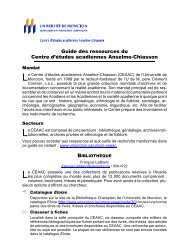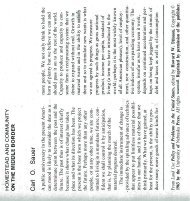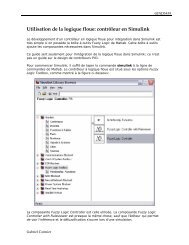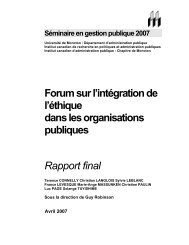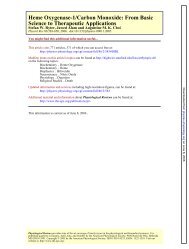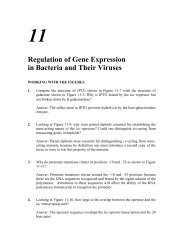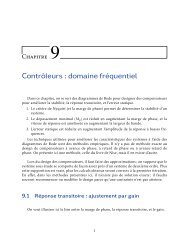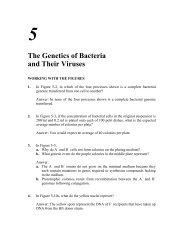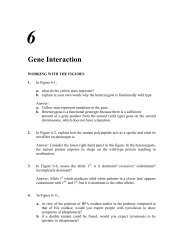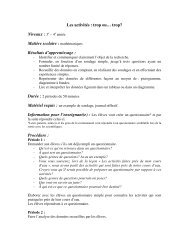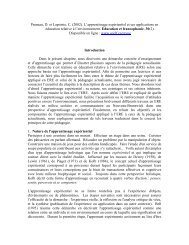<strong>Chapter</strong> Two 41independent variables in the data. Generally, the degrees of freedom can becalculated as the number of phenotypes in the problem minus one. In thisexample, there are two phenotypes (purple and blue) and therefore, one degreeof freedom. Using the table, you will find that the data have a p value that isbetween 0.025 and 0.01. The p value is the probability that the deviation of theobserved from that expected is due to chance alone. The relative standardcommonly used in biological research for rejecting a hypothesis is p < 0.05. Inthis case, the data do not support the hypothesis.Unpacking the Problem71. A man’s grandfather has galactosemia, a rare autosomal recessive diseasecaused by the inability to process galactose, leading to muscle, nerve, andkidney malfunction. The man married a woman whose sister had galactosemia.The woman is now pregnant with their first child.a. Draw the pedigree as described.b. What is the probability that this child will have galactosemia?c. If the first child does have galactosemia, what is the probability that asecond child will have it?Solution to the ProblemAnswer:a. Galactosemia pedigree?b. Both parents must be heterozygous for this child to have a 1 / 4 chance ofinheriting the disease. Since the mother’s sister is affected withgalactosemia, their parents must have both been heterozygous. Since themother does not have the trait, there is a 2 / 3 chance that she is a carrier(heterozygous). One of the father’s parents must be a carrier since hisgrandfather had the recessive trait. Thus, the father had a 1 / 2 chance ofinheriting the allele from that parent. Since these are all independent events,the child’s risk is:1/ 4 2 / 3 1 / 2 = 1 / 12c. If the child has galactosemia, both parents must be carriers and thus thoseprobabilities become 100 percent. Now all future children have a 1 / 4 chanceof inheriting the disease.
42 <strong>Chapter</strong> TwoCHALLENGING PROBLEMS72. A geneticist working on peas has a single plant monohybrid Y/y (yellow) and,from a self of this plant, wants to produce a plant of genotype y/y to use as atester. How many progeny plants need to be grown to be 95% sure of obtainingat least one in the sample?Answer: The probability of obtaining y/y; r/r from this cross is 1 / 16 , and theprobability of not obtaining this is 15 / 16 . Since only one plant is needed, theprobability of not getting this genotype in n trials is ( 15 / 16 ) n . Because theprobability of failure must be no greater than 5 percent:( 15 / 16 ) n < 0.05n > 46.42, or 47 plants73. A curious polymorphism in human populations has to do with the ability to curlup the sides of the tongue to make a trough (“tongue rolling”). Some people cando this trick, and others simply cannot. Hence, it is an example of adimorphism. Its significance is a complete mystery. In one family, a boy wasunable to roll his tongue but, to his great chagrin, his sister could. Furthermore,both his parents were rollers, and so were both grandfathers, one paternal uncle,and one paternal aunt. One paternal aunt, one paternal uncle, and one maternaluncle could not roll their tongues.a. Draw the pedigree for this family, defining your symbols clearly, anddeduce the genotypes of as many individual members as possible.b. The pedigree that you drew is typical of the inheritance of tongue rollingand led geneticists to come up with the inheritance mechanism that no doubtyou came up with. However, in a study of 33 pairs of identical twins, bothmembers of 18 pairs could roll, neither member of 8 pairs could roll, andone of the twins in 7 pairs could roll but the other could not. Becauseidentical twins are derived from the splitting of one fertilized egg into twoembryos, the members of a pair must be genetically identical. How can theexistence of the seven discordant pairs be reconciled with your geneticexplanation of the pedigree?Answer:a. In order to draw this pedigree, you should realize that if an individual’sstatus is not mentioned, then there is no way to assign a genotype to thatperson. The parents of the boy in question had a phenotype (and genotype)that differed from his. Therefore, both parents were heterozygous and theboy, who is a non-roller, is homozygous recessive. Let R stand for theability to roll the tongue and r stand for the inability to roll the tongue. Thepedigree becomes:




